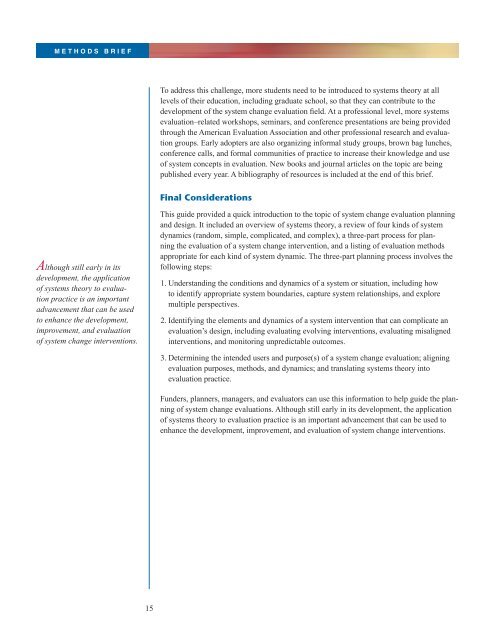Evaluating System Change - Mathematica Policy Research
Evaluating System Change - Mathematica Policy Research
Evaluating System Change - Mathematica Policy Research
Create successful ePaper yourself
Turn your PDF publications into a flip-book with our unique Google optimized e-Paper software.
M E T H O D S B R I E F<br />
Although still early in its<br />
development, the application<br />
of systems theory to evaluation<br />
practice is an important<br />
advancement that can be used<br />
to enhance the development,<br />
improvement, and evaluation<br />
of system change interventions.<br />
15<br />
To address this challenge, more students need to be introduced to systems theory at all<br />
levels of their education, including graduate school, so that they can contribute to the<br />
development of the system change evaluation field. At a professional level, more systems<br />
evaluation–related workshops, seminars, and conference presentations are being provided<br />
through the American Evaluation Association and other professional research and evaluation<br />
groups. Early adopters are also organizing informal study groups, brown bag lunches,<br />
conference calls, and formal communities of practice to increase their knowledge and use<br />
of system concepts in evaluation. New books and journal articles on the topic are being<br />
published every year. A bibliography of resources is included at the end of this brief.<br />
Final Considerations<br />
This guide provided a quick introduction to the topic of system change evaluation planning<br />
and design. It included an overview of systems theory, a review of four kinds of system<br />
dynamics (random, simple, complicated, and complex), a three-part process for planning<br />
the evaluation of a system change intervention, and a listing of evaluation methods<br />
appropriate for each kind of system dynamic. The three-part planning process involves the<br />
following steps:<br />
1. Understanding the conditions and dynamics of a system or situation, including how<br />
to identify appropriate system boundaries, capture system relationships, and explore<br />
multiple perspectives.<br />
2. Identifying the elements and dynamics of a system intervention that can complicate an<br />
evaluation’s design, including evaluating evolving interventions, evaluating misaligned<br />
interventions, and monitoring unpredictable outcomes.<br />
3. Determining the intended users and purpose(s) of a system change evaluation; aligning<br />
evaluation purposes, methods, and dynamics; and translating systems theory into<br />
evaluation practice.<br />
Funders, planners, managers, and evaluators can use this information to help guide the planning<br />
of system change evaluations. Although still early in its development, the application<br />
of systems theory to evaluation practice is an important advancement that can be used to<br />
enhance the development, improvement, and evaluation of system change interventions.
















